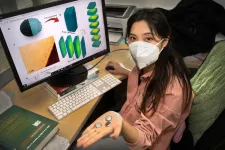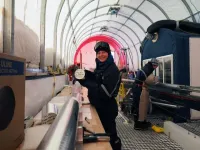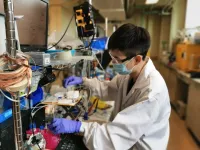(Press-News.org) KINGSTON, R.I. - June 3, 2021 - Scientists from the University of Rhode Island have taken the first steps toward understanding the function of microbes that live on and in Eastern oysters, which may have implications for oyster health and the management of oyster reefs and aquaculture facilities.
"Marine invertebrates like oysters, corals and sponges have a very active microbiome that could potentially play a role in the function of the organism itself," said Ying Zhang, URI associate professor of cell and molecular biology. "We know very little about whether there are resident microbes in oysters, and if there are, what their function may be or how they may help or bring harm to the oyster."
Zhang and doctoral student Zachary Pimentel extracted the DNA of microbes living in or on the gut, gill, inner shell, mantle and other tissues of oysters to identify the microbes that live there. They then applied a metagenomics technology to reconstruct the genome of the most abundant microbes to better understand the nature of the oyster microbiome and the function of some of the microbes.
"This was the first overview of what microbes live in certain parts of Eastern oysters," said Pimentel, the lead author on a paper about the study published in May by the American Society for Microbiology. "In humans, we know that the microbes that live in the gut versus the skin are quite different. But we didn't know about the compartmentalization of certain microbes in certain oyster tissues."
The researchers identified one microbe, a bacterium in the class Mollicutes, that gains energy from the consumption of chitin, a substance found throughout the marine environment. It was most abundant in the gut of the oysters and appears to be an indicator of a healthy oyster, but when found in other tissues, it may be correlated with infections.
"When they're abundant in the gut of healthy oysters, that may indicate that the oysters are happy to have them," Zhang said. "But when the microbe gains abundance in other tissues, that may be a sign that the oyster is not doing well, maybe because the immune system is freaked out."
The same microbe was also discovered to consume arginine, an amino acid found in all organisms that is used to create proteins.
"We're really interested in that one because it has potential implications for the immune system of oysters," Pimentel said. "Oysters rely on arginine for its immune response. A pathogen has been found to steal the arginine to hide from the oyster's immune system, so it's really interesting that there's another microbe that uses arginine and has potential implications for oyster immunity."
Once the researchers have identified the function of key beneficial microbes, the next step is to learn when and where the microbes are acquired.
"One microbe was found to be abundant in adult oysters but very rare in larval samples," Zhang said. "So they could be acquired at some point in their growth, but when and how they are acquired is a big question. If we know they are important and we can identify the source of where they came from, then perhaps we can help preserve the population of this specific microbe."
According to Zhang and Pimentel, oysters play an important role in building reefs, filtering water, and providing other ecological functions, in addition to their role in supporting the aquaculture industry. Further research about the microbiome of oysters could be beneficial to understanding more about oyster health and the health of their ecosystem.
"We know for other organisms that the microbiome is a really important factor when considering health and disease, so we're laying the groundwork for future research that might implicate certain microbes in important processes related to health and disease," Pimentel said.
"The more we know about oysters and their interactions with microbes, the more we'll understand about how to conserve them," added Zhang.
INFORMATION:
ANN ARBOR, Mich. -- A different type of surge may be on the way more than a year into the pandemic - a baby surge.
The COVID-19 shutdown initially seemed to hit pause on pregnancy and birth rates, new research from one major hospital system suggests, but that trend is quickly reversing.
"Birth rates declined early on in the pandemic, but we expect a dramatic rebound soon," says lead author Molly Stout, M.D., MSci, maternal fetal medicine director at Michigan Medicine Von Voigtlander Women's Hospital.
"We're already seeing signs of a summer baby surge."
While infectious ...
UPTON, NY--A team of researchers led by chemists at the U.S. Department of Energy's (DOE) Brookhaven National Laboratory has studied an elusive property in cathode materials, called a valence gradient, to understand its effect on battery performance. The findings, published in Nature Communications, demonstrated that the valence gradient can serve as a new approach for stabilizing the structure of high-nickel-content cathodes against degradation and safety issues.
High-nickel-content cathodes have captured the attention of scientists for their high capacity, a chemical property that could power electric vehicles over much longer distances than current batteries support. Unfortunately, the high nickel content also causes these cathode materials to degrade more quickly, creating cracks ...
The South Pole and the rest of East Antarctica is cold now and was even more frigid during the most recent ice age around 20,000 years ago -- but not quite as cold as previously believed.
University of Washington glaciologists are co-authors on two papers that analyzed Antarctic ice cores to understand the continent's air temperatures during the most recent glacial period. The results help understand how the region behaves during a major climate transition.
In one paper, an international team of researchers, including three at the UW, analyzed seven ice cores from across West and East Antarctica. The results published June 3 in Science show warmer ice age temperatures in the eastern part of the continent.
The team ...
Scientists have gained the best view yet of the brightest explosions in the universe: A specialised observatory in Namibia has recorded the most energetic radiation and longest gamma-ray afterglow of a so-called gamma-ray burst (GRB) to date. The observations with the High Energy Stereoscopic System (H.E.S.S.) challenge the established idea of how gamma-rays are produced in these colossal stellar explosions which are the birth cries of black holes, as the international team reports in the journal Science.
"Gamma-ray bursts are bright X-ray and gamma-ray flashes observed in the sky, emitted by distant extragalactic sources," explains DESY scientist Sylvia Zhu, one of the authors of the ...
The biggest shark attack in history did not involve humans.
A new study by Earth scientists from Yale and the College of the Atlantic has turned up a massive die-off of sharks roughly 19 million years ago. It came at a period in history when there were more than 10 times more sharks patrolling the world's oceans than there are today.
For now, researchers don't know the cause of the shark die-off.
"We happened upon this extinction almost by accident," said Elizabeth Sibert, a Hutchinson postdoctoral associate in Yale's Department of Earth and Planetary Sciences and ...
Scientists have developed the first cells that can construct artificial polymers from building blocks that are not found in nature, by following instructions the researchers encoded in their genes.
The study, led by scientists from the Medical Research Council (MRC) Laboratory of Molecular Biology, in Cambridge, UK, also found the synthetic genome made the bacteria entirely resistant to infection by viruses.
The scientists say their research could lead to the development of new polymers - large molecules made of many repeating units, such as proteins, plastics, and many drugs including antibiotics - and make it easier to ...
Hydrogels are polymer materials made mostly from water. They can be used in a wide range of medical and other applications. However, previous incarnations of the materials suffered from repeated mechanical stress and would easily become deformed. A novel crystal that can reversibly form and deform, allows hydrogels to rapidly recover from mechanical stress. This opens up the use of such biocompatible materials in the field of artificial joints and ligaments.
Many of us suffer the occasional sports injury or experience some kind of pain relating to joints and ligaments at some point in our lives. ...
Researchers from University of Toronto Engineering have developed an improved electrochemical system that raises the value of captured CO2 by converting more of it into valuable products than ever before.
The International Energy Agency recently cited carbon capture and storage as one of the strategies that can help keep global emissions low enough to limit global warming to 1.5 C by 2050. But captured carbon currently has little economic value, reducing the incentive for companies to invest in this technology.
A University of Toronto Engineering team led by Professor Ted Sargent is addressing this challenge by designing advanced electrolyzers that use electricity to convert captured CO2 into the petrochemical building blocks of common everyday materials, ...
An engineering researcher from the University of Sydney, in collaboration with a team at the University of Toronto, has developed an electrochemical system that coverts a greater amount of CO2 into valuable products.
The International Energy Agency recently cited carbon capture and storage as a strategy that can help keep global emissions low enough to limit global warming to 1.5°C by 2050. However, captured carbon currently has little economic value, reducing the incentive for companies to invest in this technology.
The team of researchers has addressed this challenge by designing advanced electrolysers - machines using electricity to convert captured CO2, plus water, into the building blocks of common everyday materials, ...
Astronomers have measured very-high-energy gamma rays coming from the aftermath of a gamma ray burst - an enormously energetic explosion of a star in another galaxy. The results shine light on these immensely powerful but little-understood cosmic events, and challenge standard models of how gamma ray bursts radiate light during their afterglow phases. As a dying massive star enters its final death throes, its core begins to collapse, and then explodes as a supernova. Some types of supernovae generate jets of particles moving at close to the speed of light; if the jet is pointed directly towards Earth it can be observed as a burst of gamma ray radiation that lasts several seconds. These gamma ray bursts are sometimes ...



